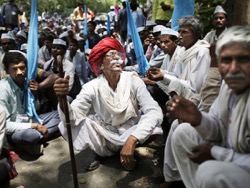
As reported Financial Times in the state of Maharashtra to the East of 18 million Mumbai, there was a mass suicide of farmers. Journalist Simon Mundy counted 320 people who have committed suicide in the current 2016 only one of the five areas of the state — Marathwada. People are desperate because of the threat of a severe drought that looms over the Western and South-Central regions of the country, where 55% of the acreage, including sugar cane, irrigated solely by rain.
The reason for the disaster was the weakest in many years, the monsoon season, causing food prices soared. Meteorological service of India binds a weather anomaly with the emerging El niño. El Niño — “the Kid”) with the phenomenon studied, and at the same time extremely dangerous. It is characterized by a temperature increase of a huge volume of water in the Pacific Ocean at 5-9° C. the Area of this giant flow is 100 million square kilometers, and its thermal energy is estimated at 450 million megawatts. The impression that shines not one but two suns.
Recall that prior to the arrival of “Baby”, dlivre from June 2009 to April 2012, caused the most cruel drought in India over the past four decades. However, the respite proved to be small. And in the fall of 2015, the world meteorological organization has forecast about a new “El niño”, which may be the most destructive for the last 70 years. And when you consider that over the years “the Kid” sports a more, longer and more aggressive, it is quite possible that one day he will stay forever with short breaks at cold “sleep”. This will be payback for the overheating of the atmosphere.
Of course, mankind suffers, but the greatest damage climate change will cause it to India, I’m sure Scott Moore, who the U.S. state Department explores world Aqua problem. According to him, in the near future, South Asia will face severe water shortages, which will lead not only to a drop in GDP of regional countries, but also to their state of instability.
The fact that the weakening of the monsoon makes India is critically dependent on the Ganga and its tributaries. Outside these areas water is of particular value because of depleted soil and artesian water. Its already there in many areas. And although agriculture, consuming 90% of water resources, gives only 20% of India’s GDP, the number of employees in the food sector in some States reaches 55%. The problem is aggravated by a hot climate.
The most acute contradictions may arise between the States of Punjab and Haryana. To explosive ethnic and religious issue involving Hindus, Muslims and Sikhs, added the fierce disputes over water scarcity. The Supreme court of India requires from new Delhi urgent solutions. But the Central government hesitates, rightly fearing separatism economically developed Punjab, which accounts for 60% of wheat, 50% rice and 25% cotton, purchased by the authorities.
In General, state regulation of water use in India is historically impossible. The country is literally woven from the national parties that defend the interests of ethnic and religious groups. In these circumstances, to make the supply of water from one area to another is always very difficult and, moreover, is fraught with armed conflict. The downside becomes blackmail. So, in February, the caste of jats blocked the channel Munak, which is 60% of the water supply of 16 million, Delhi. The uprising had been brutally suppressed by the army, and still the authorities had to make concessions and to allocate the JAT quota in government and the universities of Delhi and Haryana.
Scott Moore to the current water conflict blames the legacy of British colonial rule, which was opposed to the regions along the rivers and principalities that were in the hinterland. In other words, we are talking about the traditional conflicts with the bloody background. They usually are extinguished only with the growth of well-being. However, the rural population, in contrast to residents of cities, is still very poor.
Another issue is cumulative. Began to melt the glaciers of the Himalayas. More evidence of this publish, scientists and journalists from different countries. So, BBC News told of the overflow of the lake, Spillway, which is fed by Ngozumpa, located 20 kilometers away from mount Everest. Dr. Doug Benn from Svalbard (Norway) noted that the glacier has become porous as cheese. The Chinese spoke about the two new lakes in the Central part of the Himalayas in the region of the ridge Alcancar Himal. And here humanity is to blame, writes the journal Atmospheric Chemistry and Physics, the pages of which are evidence of the appearance of soot on the glaciers.
Excess water due to accelerated melting of the Himalayas in large part fills the Brahmaputra river, which is one of the largest waterways in South Asia. Her water consumption is 19 500 cubic meters per second. Half of the river basin falls into the territory of China.
If the agreement with Pakistan on the Indus waters has stood the test of time, between Beijing and new Delhi regarding the Brahmaputra agreement no. There is a risk that the Chinese still build on the river a cascade of five medium-sized hydropower and dramatically increase the water intake for their needs.
In case of environmental disaster without water will remain the Indian States of Tripura and Sikkim, Arunachal Pradesh, Assam, Manipur, Meghalaya, Mizoram, Nagaland. Despite the fact that the parties avoid militant rhetoric, Scott Moore is convinced that the water conflict between neighbors-the giants are not settled, but deferred. The situation will certainly deteriorate in direct proportion to the increase in the average temperature of the earth’s surface.
Thus, lack of water is the most underestimated challenge to India as to power, claiming the status of great. Moreover, with high probability we can assume that in its territory can be several quasi-state that will start war for water resources.
In this regard, the United States imposed on India by the special program. If someone believes that Delhi will bat it away like an annoying fly, it is not so. Influential members of the lower house of India — Lok Sabha, actively supported the US proposals, which promise to become allies in case of conflict with China. Scott Moore has opened up some of the details of the initiatives of the state Department. First of all, we are talking about the creation of the all-India Tribunal to resolve water disputes between States as well as of enforcement mechanisms, including the special forces. As for Russia, our country is not “weaves intrigue, preferring to maintain equal relations with both Beijing and new Delhi. This is exactly the case when the status quo is the best solution, even if it will lead to a reduction in the supply of our arms in India.
In short, the WA government urges Narendra modi not to pay attention to ethnic and religious specificities of the state. Apparently, America is a little concerned about the prospect of the Indian civil wars, which, as we know, are the very blood and violent. After the water court reform Washington is ready to implement in India a number of technical projects on quotas and allocation of water resources. Interestingly, about water saving initiatives in the U.S. almost says nothing, as Delhi and so directs tens of billions of dollars on this. In fairness, the Indian government adheres to its program on irrigation, although in contact with the state Department on this issue.
How will the events develop, it is only known to the chief of the “heavenly office”. However, recall that “El niño” 2009-2012 provoked a sharp rise in world food prices, then political catastrophe in Egypt and Libya the death, then the so — called Arab spring and then the Syrian civil war.








